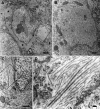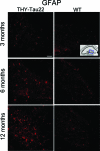Alzheimer's disease-like tau neuropathology leads to memory deficits and loss of functional synapses in a novel mutated tau transgenic mouse without any motor deficits
- PMID: 16877359
- PMCID: PMC1698785
- DOI: 10.2353/ajpath.2006.060002
Alzheimer's disease-like tau neuropathology leads to memory deficits and loss of functional synapses in a novel mutated tau transgenic mouse without any motor deficits
Abstract
Tau transgenic mice are valuable models to investigate the role of tau protein in Alzheimer's disease and other tauopathies. However, motor dysfunction and dystonic posture interfering with behavioral testing are the most common undesirable effects of tau transgenic mice. Therefore, we have generated a novel mouse model (THY-Tau22) that expresses human 4-repeat tau mutated at sites G272V and P301S under a Thy1.2-promotor, displaying tau pathology in the absence of any motor dysfunction. THY-Tau22 shows hyperphosphorylation of tau on several Alzheimer's disease-relevant tau epitopes (AT8, AT100, AT180, AT270, 12E8, tau-pSer396, and AP422), neurofibrillary tangle-like inclusions (Gallyas and MC1-positive) with rare ghost tangles and PHF-like filaments, as well as mild astrogliosis. These mice also display deficits in hippocampal synaptic transmission and impaired behavior characterized by increased anxiety, delayed learning from 3 months, and reduced spatial memory at 10 months. There are no signs of motor deficits or changes in motor activity at any age investigated. This mouse model therefore displays the main features of tau pathology and several of the pathophysiological disturbances observed during neurofibrillary degeneration. This model will serve as an experimental tool in future studies to investigate mechanisms underlying cognitive deficits during pathogenic tau aggregation.
Figures










Similar articles
-
A novel transgenic mouse expressing double mutant tau driven by its natural promoter exhibits tauopathy characteristics.Exp Neurol. 2008 Jul;212(1):71-84. doi: 10.1016/j.expneurol.2008.03.007. Epub 2008 Mar 21. Exp Neurol. 2008. PMID: 18490011
-
Truncated tau at D421 is associated with neurodegeneration and tangle formation in the brain of Alzheimer transgenic models.Acta Neuropathol. 2009 Jun;117(6):687-97. doi: 10.1007/s00401-009-0491-6. Epub 2009 Feb 4. Acta Neuropathol. 2009. PMID: 19190923
-
Divergent phosphorylation pattern of tau in P301L tau transgenic mice.Eur J Neurosci. 2008 Jul;28(1):137-47. doi: 10.1111/j.1460-9568.2008.06318.x. Eur J Neurosci. 2008. PMID: 18662339
-
Deletion of murine tau gene increases tau aggregation in a human mutant tau transgenic mouse model.Biochem Soc Trans. 2010 Aug;38(4):1001-5. doi: 10.1042/BST0381001. Biochem Soc Trans. 2010. PMID: 20658993 Review.
-
Regulatable transgenic mouse models of Alzheimer disease: onset, reversibility and spreading of Tau pathology.FEBS J. 2013 Sep;280(18):4371-81. doi: 10.1111/febs.12250. Epub 2013 Apr 22. FEBS J. 2013. PMID: 23517246 Review.
Cited by
-
Does obesity-induced τ phosphorylation tip the scale toward dementia?Diabetes. 2013 May;62(5):1365-6. doi: 10.2337/db12-1784. Diabetes. 2013. PMID: 23613550 Free PMC article. No abstract available.
-
Tau monoclonal antibody generation based on humanized yeast models: impact on Tau oligomerization and diagnostics.J Biol Chem. 2015 Feb 13;290(7):4059-74. doi: 10.1074/jbc.M114.627919. Epub 2014 Dec 24. J Biol Chem. 2015. PMID: 25540200 Free PMC article.
-
Modeling the β-secretase cleavage site and humanizing amyloid-beta precursor protein in rat and mouse to study Alzheimer's disease.Mol Neurodegener. 2020 Oct 19;15(1):60. doi: 10.1186/s13024-020-00399-z. Mol Neurodegener. 2020. PMID: 33076948 Free PMC article.
-
Active immunization with tau epitope in a mouse model of tauopathy induced strong antibody response together with improvement in short memory and pSer396-tau pathology.Neurobiol Dis. 2020 Feb;134:104636. doi: 10.1016/j.nbd.2019.104636. Epub 2019 Oct 17. Neurobiol Dis. 2020. PMID: 31629891 Free PMC article.
-
APPsα Rescues Tau-Induced Synaptic Pathology.J Neurosci. 2022 Jul 20;42(29):5782-5802. doi: 10.1523/JNEUROSCI.2200-21.2022. Epub 2022 Jun 6. J Neurosci. 2022. PMID: 35667850 Free PMC article.
References
-
- Arendt T, Bigl V, Arendt A, Tennstedt A. Loss of neurons in the nucleus basalis of Meynert in Alzheimer’s disease, paralysis agitans and Korsakoff’s Disease. Acta Neuropathol (Berl) 1983;61:101–108. - PubMed
-
- Scott SA, DeKosky ST, Sparks DL, Knox CA, Scheff SW. Amygdala cell loss and atrophy in Alzheimer’s disease. Ann Neurol. 1992;32:555–563. - PubMed
-
- West MJ, Coleman PD, Flood DG, Troncoso JC. Differences in the pattern of hippocampal neuronal loss in normal ageing and Alzheimer’s disease. Lancet. 1994;344:769–772. - PubMed
-
- Blasko I, Stampfer-Kountchev M, Robatscher P, Veerhuis R, Eikelenboom P, Grubeck-Loebenstein B. How chronic inflammation can affect the brain and support the development of Alzheimer’s disease in old age: the role of microglia and astrocytes. Aging Cell. 2004;3:169–176. - PubMed
Publication types
MeSH terms
Substances
LinkOut - more resources
Full Text Sources
Other Literature Sources
Medical
Molecular Biology Databases
Miscellaneous

